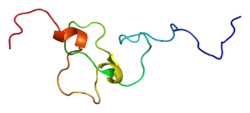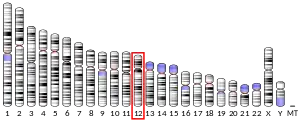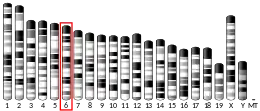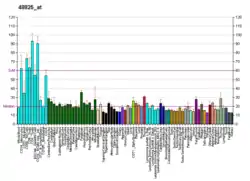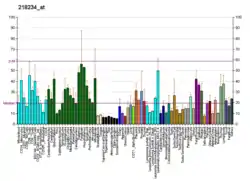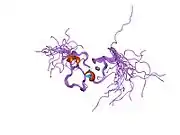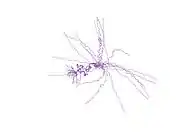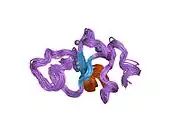Inhibitor of growth protein 4 is a protein that in humans is encoded by the ING4 gene.[5][6]
Function
The protein encoded by this gene is similar to ING1, a tumor suppressor protein that can interact with TP53, inhibit cell growth, and induce apoptosis. This protein contains a PHD-finger, which is a common motif in proteins involved in chromatin remodeling. This protein can bind TP53 and EP300/p300, a component of the histone acetyl transferase complex, suggesting its involvement in the TP53-dependent regulatory pathway. Alternatively spliced transcript variants have been observed, but the biological validity of them has not been determined.[6]
Interactions
ING4 has been shown to interact with EP300,[5] RELA[7] and P53.[5][8]
References
- 1 2 3 GRCh38: Ensembl release 89: ENSG00000111653 - Ensembl, May 2017
- 1 2 3 GRCm38: Ensembl release 89: ENSMUSG00000030330 - Ensembl, May 2017
- ↑ "Human PubMed Reference:". National Center for Biotechnology Information, U.S. National Library of Medicine.
- ↑ "Mouse PubMed Reference:". National Center for Biotechnology Information, U.S. National Library of Medicine.
- 1 2 3 Shiseki M, Nagashima M, Pedeux RM, Kitahama-Shiseki M, Miura K, Okamura S, Onogi H, Higashimoto Y, Appella E, Yokota J, Harris CC (May 2003). "p29ING4 and p28ING5 bind to p53 and p300, and enhance p53 activity". Cancer Research. 63 (10): 2373–8. PMID 12750254.
- 1 2 "Entrez Gene: ING4 inhibitor of growth family, member 4".
- ↑ Garkavtsev I, Kozin SV, Chernova O, Xu L, Winkler F, Brown E, Barnett GH, Jain RK (March 2004). "The candidate tumour suppressor protein ING4 regulates brain tumour growth and angiogenesis". Nature. 428 (6980): 328–32. Bibcode:2004Natur.428..328G. doi:10.1038/nature02329. PMID 15029197. S2CID 4427531.
- ↑ Tsai KW, Tseng HC, Lin WC (October 2008). "Two wobble-splicing events affect ING4 protein subnuclear localization and degradation". Experimental Cell Research. 314 (17): 3130–41. doi:10.1016/j.yexcr.2008.08.002. PMID 18775696.
Further reading
- Ozer A, Bruick RK (September 2005). "Regulation of HIF by prolyl hydroxylases: recruitment of the candidate tumor suppressor protein ING4". Cell Cycle. 4 (9): 1153–6. doi:10.4161/cc.4.9.2040. PMID 16096374.
- Bonaldo MF, Lennon G, Soares MB (September 1996). "Normalization and subtraction: two approaches to facilitate gene discovery". Genome Research. 6 (9): 791–806. doi:10.1101/gr.6.9.791. PMID 8889548.
- Hu RM, Han ZG, Song HD, Peng YD, Huang QH, Ren SX, Gu YJ, Huang CH, Li YB, Jiang CL, Fu G, Zhang QH, Gu BW, Dai M, Mao YF, Gao GF, Rong R, Ye M, Zhou J, Xu SH, Gu J, Shi JX, Jin WR, Zhang CK, Wu TM, Huang GY, Chen Z, Chen MD, Chen JL (August 2000). "Gene expression profiling in the human hypothalamus-pituitary-adrenal axis and full-length cDNA cloning". Proceedings of the National Academy of Sciences of the United States of America. 97 (17): 9543–8. Bibcode:2000PNAS...97.9543H. doi:10.1073/pnas.160270997. PMC 16901. PMID 10931946.
- Garkavtsev I, Kozin SV, Chernova O, Xu L, Winkler F, Brown E, Barnett GH, Jain RK (March 2004). "The candidate tumour suppressor protein ING4 regulates brain tumour growth and angiogenesis". Nature. 428 (6980): 328–32. Bibcode:2004Natur.428..328G. doi:10.1038/nature02329. PMID 15029197. S2CID 4427531.
- Zhang X, Xu LS, Wang ZQ, Wang KS, Li N, Cheng ZH, Huang SZ, Wei DZ, Han ZG (July 2004). "ING4 induces G2/M cell cycle arrest and enhances the chemosensitivity to DNA-damage agents in HepG2 cells". FEBS Letters. 570 (1–3): 7–12. doi:10.1016/j.febslet.2004.06.010. PMID 15251430. S2CID 12379202.
- Gerhard DS, Wagner L, Feingold EA, Shenmen CM, Grouse LH, Schuler G, Klein SL, Old S, Rasooly R, Good P, Guyer M, Peck AM, Derge JG, Lipman D, Collins FS, Jang W, Sherry S, Feolo M, Misquitta L, Lee E, Rotmistrovsky K, Greenhut SF, Schaefer CF, Buetow K, Bonner TI, Haussler D, Kent J, Kiekhaus M, Furey T, Brent M, Prange C, Schreiber K, Shapiro N, Bhat NK, Hopkins RF, Hsie F, Driscoll T, Soares MB, Casavant TL, Scheetz TE, Brown-stein MJ, Usdin TB, Toshiyuki S, Carninci P, Piao Y, Dudekula DB, Ko MS, Kawakami K, Suzuki Y, Sugano S, Gruber CE, Smith MR, Simmons B, Moore T, Waterman R, Johnson SL, Ruan Y, Wei CL, Mathavan S, Gunaratne PH, Wu J, Garcia AM, Hulyk SW, Fuh E, Yuan Y, Sneed A, Kowis C, Hodgson A, Muzny DM, McPherson J, Gibbs RA, Fahey J, Helton E, Ketteman M, Madan A, Rodrigues S, Sanchez A, Whiting M, Madari A, Young AC, Wetherby KD, Granite SJ, Kwong PN, Brinkley CP, Pearson RL, Bouffard GG, Blakesly RW, Green ED, Dickson MC, Rodriguez AC, Grimwood J, Schmutz J, Myers RM, Butterfield YS, Griffith M, Griffith OL, Krzywinski MI, Liao N, Morin R, Morrin R, Palmquist D, Petrescu AS, Skalska U, Smailus DE, Stott JM, Schnerch A, Schein JE, Jones SJ, Holt RA, Baross A, Marra MA, Clifton S, Makowski KA, Bosak S, Malek J (October 2004). "The status, quality, and expansion of the NIH full-length cDNA project: the Mammalian Gene Collection (MGC)". Genome Research. 14 (10B): 2121–7. doi:10.1101/gr.2596504. PMC 528928. PMID 15489334.
- Kim S, Chin K, Gray JW, Bishop JM (November 2004). "A screen for genes that suppress loss of contact inhibition: identification of ING4 as a candidate tumor suppressor gene in human cancer". Proceedings of the National Academy of Sciences of the United States of America. 101 (46): 16251–6. Bibcode:2004PNAS..10116251K. doi:10.1073/pnas.0407158101. PMC 528940. PMID 15528276.
- Zhang X, Wang KS, Wang ZQ, Xu LS, Wang QW, Chen F, Wei DZ, Han ZG (June 2005). "Nuclear localization signal of ING4 plays a key role in its binding to p53". Biochemical and Biophysical Research Communications. 331 (4): 1032–8. doi:10.1016/j.bbrc.2005.04.023. PMID 15882981.
- Ozer A, Wu LC, Bruick RK (May 2005). "The candidate tumor suppressor ING4 represses activation of the hypoxia inducible factor (HIF)". Proceedings of the National Academy of Sciences of the United States of America. 102 (21): 7481–6. Bibcode:2005PNAS..102.7481O. doi:10.1073/pnas.0502716102. PMC 1140452. PMID 15897452.
- Gunduz M, Nagatsuka H, Demircan K, Gunduz E, Cengiz B, Ouchida M, Tsujigiwa H, Yamachika E, Fukushima K, Beder L, Hirohata S, Ninomiya Y, Nishizaki K, Shimizu K, Nagai N (August 2005). "Frequent deletion and down-regulation of ING4, a candidate tumor suppressor gene at 12p13, in head and neck squamous cell carcinomas". Gene. 356: 109–17. doi:10.1016/j.gene.2005.02.014. PMID 15935570.
- Rual JF, Venkatesan K, Hao T, Hirozane-Kishikawa T, Dricot A, Li N, Berriz GF, Gibbons FD, Dreze M, Ayivi-Guedehoussou N, Klitgord N, Simon C, Boxem M, Milstein S, Rosenberg J, Goldberg DS, Zhang LV, Wong SL, Franklin G, Li S, Albala JS, Lim J, Fraughton C, Llamosas E, Cevik S, Bex C, Lamesch P, Sikorski RS, Vandenhaute J, Zoghbi HY, Smolyar A, Bosak S, Sequerra R, Doucette-Stamm L, Cusick ME, Hill DE, Roth FP, Vidal M (October 2005). "Towards a proteome-scale map of the human protein-protein interaction network". Nature. 437 (7062): 1173–8. Bibcode:2005Natur.437.1173R. doi:10.1038/nature04209. PMID 16189514. S2CID 4427026.
- Kim SC, Sprung R, Chen Y, Xu Y, Ball H, Pei J, Cheng T, Kho Y, Xiao H, Xiao L, Grishin NV, White M, Yang XJ, Zhao Y (August 2006). "Substrate and functional diversity of lysine acetylation revealed by a proteomics survey". Molecular Cell. 23 (4): 607–18. doi:10.1016/j.molcel.2006.06.026. PMID 16916647.
- Unoki M, Shen JC, Zheng ZM, Harris CC (November 2006). "Novel splice variants of ING4 and their possible roles in the regulation of cell growth and motility". The Journal of Biological Chemistry. 281 (45): 34677–86. doi:10.1074/jbc.M606296200. PMID 16973615.
- Raho G, Miranda C, Tamborini E, Pierotti MA, Greco A (August 2007). "Detection of novel mRNA splice variants of human ING4 tumor suppressor gene". Oncogene. 26 (36): 5247–57. doi:10.1038/sj.onc.1210335. PMID 17325660.
- Zhang X, Lin DH, Jin Y, Wang KS, Zhang Y, Babilonia E, Wang Z, Wang Z, Giebisch G, Han ZG, Wang WH (May 2007). "Inhibitor of growth 4 (ING4) is up-regulated by a low K intake and suppresses renal outer medullary K channels (ROMK) by MAPK stimulation". Proceedings of the National Academy of Sciences of the United States of America. 104 (22): 9517–22. Bibcode:2007PNAS..104.9517Z. doi:10.1073/pnas.0703383104. PMC 1890526. PMID 17517644.
External links
- ING4+protein,+human at the U.S. National Library of Medicine Medical Subject Headings (MeSH)
This article incorporates text from the United States National Library of Medicine, which is in the public domain.
